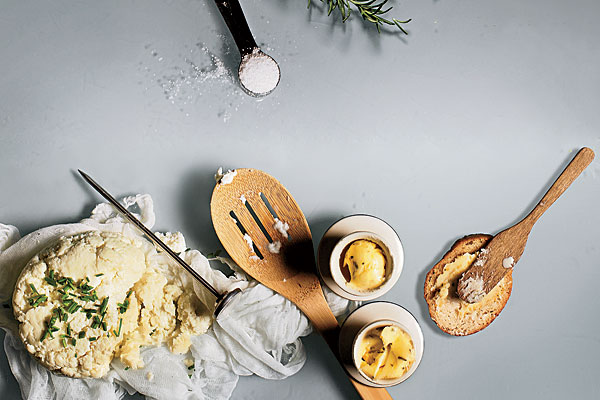
Flip through the catalog of a certain high-end kitchenware and specialty food retailer and you’ll find a retro-cool hand-crank grain grinder for milling your own flour, a fruit press for making your own cider and wine, and—for those whose idea of “farm fresh” means plucking eggs still warm from the nest—a backyard chicken coop made from reclaimed wood.
All this may sound like a goofy sketch from Portlandia, but like ready-to-be-foraged wild onions, the agrarian food trend is creeping beyond the latest farm-to-table hot spot and into our personal kitchens. My condo’s balcony has scarcely enough space for a patio set, let alone a chicken run, so I got resourceful. A variety of urban-friendly DIY kits promise easy-to-make staples that would be fresher and cheaper than the stuff I get from the store. In hopes of carving out my own little slice of the nouveau homesteader life, I tried my hand at a few of these uber-local products.
Cheese making is a time-honored food craft and, I soon realized, one that involves a basic understanding of science. My box’s contents featured intimidating items such as tablets of rennet (enzymes that coagulate milk), citric acid (which gives cheese its stretch), and a cooking thermometer. Motivated by the fact that this was a science project I could eat, I pulled out my trusty Le Creuset and dumped in a gallon of pasteurized whole milk that I hoped to transform into fresh mozzarella.
After pouring one and a half tablespoons of dissolved citric acid into the pot of sleek ivory liquid, I gingerly fired up the burner to medium heat and watched the tiny thermometer make the slow climb to 90 degrees. When the milk reached the magic number, I hit it with the rennet, and almost immediately something magical happened.
Curds and whey, I discovered, were more than just words from a nursery rhyme; small white grains (curds) began coagulating atop a pool of bubbling yellow (whey). A bit of gentle stirring later, and I was ready to ladle the yogurt-like chunks into a bowl, pour off the liquid, add some salt, and fold my creation into two perfect tennis balls. The end product tasted fresh but extremely mild, and my aggressive stretching yielded a dense texture similar to that of string cheese. No matter; I was ecstatic. In under an hour, I had made my own cheese, and it was edible enough to shred onto a homemade pizza.
My relative success inspired me to attempt a wheel of goat cheese. The instructions called for the same basic steps (minus the rennet), only with the goat’s milk warmed to a much higher temperature (185 degrees) and the curds drained through cheesecloth. Again, I nailed the procedure. But despite the epicurean street cred I enjoyed by having half a gallon of goat’s milk in my fridge for a week, the supposedly exotic dairy product didn’t bring any complexity or funk to my cheese. (To add flavor, I stirred in some herbes de Provence.) Still, it felt cool to spread my very own goat cheese on crostini.
The butter kit was an even bigger success. Truly idiot-proof instructions directed me to vigorously shake a container filled with heavy cream for ten or so minutes to break down the milk fat until it formed clumps of butter grain. The process was simple but arm-numbingly labor-intensive, which I suppose is the whole point of the DIY lifestyle. And there was no denying the flavor: rich, decadent, and delicious.
While my in-house dairy factory was churning out goodies, my other DIY project refused to cooperate. I followed the directions and placed the footlong, seven-pound shiitake mushroom log in our home’s most humid environment: the bathtub. According to Howard Berk, a proprietor of 2 Fun Guys, which purveys logs preinoculated with shroom-producing spores, all my lonely hunk of wood needed was a 24-hour soaking and some sudden shifts in temperature to trigger a bumper crop of tasty fungi within a few weeks. A month later, I’m still waiting.
That’s life in a farm-to-table household: Sometimes you have to live on what nature provides.
Photograph: Anna Knott


